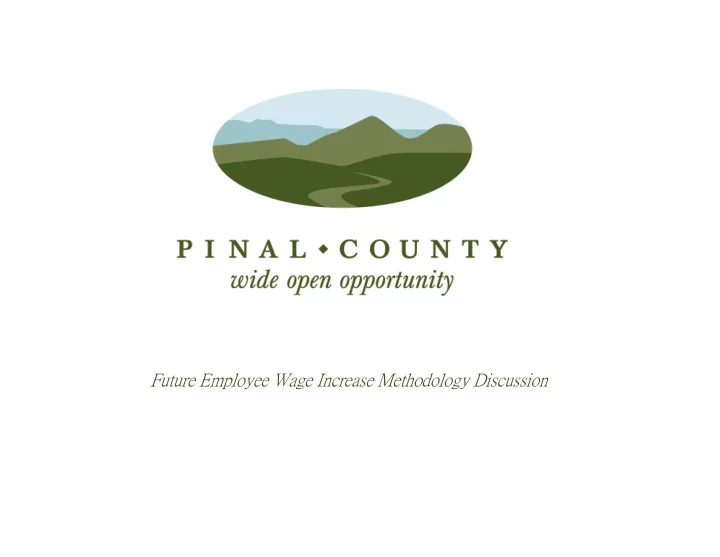

Future Employee Wage Increase Methodology Discussion
Pinal County Strategic Plan FY 2014-2017 STRATEGIC PRIORITY 6: EMPLOYEE MORALE, RETENTION, AND RECRUITMENT Strategic Goal: Become the employer of choice by increased levels of empowerment, accountability, competitive compensation which results in attraction and retention of high quality staff.
Current Status • Phase I (Bring to Minimum): Implemented April 2016. • Approx. 375 positions affected (Total Cost of Phase I $1,238,845) • Phase II (System Creation): Implemented January 2017. • Approx. 800 increases issued. All 2150 positions affected. (Total of Phase II cost $3,323,650) • Phase III (Movement in System): Development.
Wage increases going forward • Principles • No system is perfect and each come with pros and cons – striving for a good systematic balance of business needs, management motivation, flexibility, fairness, morale, consistency and accountability. • When changing systems, there is an inherent transition between the two. • Consultant and Compensation Committees examined a way to structurally balance these in a new system. Alternatives: • Wage increases for existing employees have the same rules as new hires • Pros – maximum flexibility, discretion to “ fix ” perceived “ inequities ” , no need for an additional policy. • Cons – challenge to maintain fair and consistent system (codify in policy), employee fear of favoritism and unfair treatment, discrimination complaints, new hire policies have a different criteria and purpose than existing employee policies, financial management (financial targets would still be needed with management discretion with what to do with the target). • Restrict new hire policies further • Pros – reduce the perception for existing employees that new hires are treated more favorably than them, reduce perception of internal equity. • Cons – inability to change to a more flexible hiring policy, committees expressed need for hiring flexibility which was balanced with the hiring concepts developed in policy 4.2. • Develop a performance based wage increase system (Committees ’ recommendation) • Pros – employees have a clear understanding and expectation for how pay increases are given, everyone is playing by the same rules, discriminatory of favoritism claims are mitigated by performance evaluations, an employee who consistently exceeds performance expectations will experience a meaningful difference in pay increases over time • Cons – since there is a significant change to structure and methods, it will take time for the new system results to shape and form.
Proposed Changes • New PCPP 4.25- EVALUATION AND COMPENSATION PLAN • Highlights • Flexibility • Establishes methods for across the board increases and performance pay system. • Supervisor accountability- must submit appraisals to be personally eligible for increase. • Evaluations due annually by August 31st – performance pay effective October 1st. • Appeal method- to supervisor and reviewer (supervisor ’ s boss). • HR appeal in incidents of discrimination and non-evaluation. • Maintains integrity of financial targets and departmental relativeness • FY 17/18 – Training on new system and test run to identify needed adjustments • FY 18/19 – Go live with performance pay
Proposed Changes • New Evaluation Form • Highlights • Streamlined Process • Simplified Rating • Easier understanding • Greater equity
Example • Year 1: 2% ATB • Year 2: Performance pay (money allotted is 3% of department payroll) • Needs Improvement= 0% • Successful minimum increase 2%, Exceeds Maximum 4% (possible variable rates by place within range) • Within the department all matching ratings must receive the same percent increase. • Successful ratings may not be given greater percentage increases than Exceeds ratings. • Total department salary increase cannot exceed budget target. • Unused budget is returned. • Subject to range maximum. Potential Salary Potential % Potential Salary Current Salary 3% allotment Rating Potential % increase Increase Increase Increase $50,000 Successful 2.5% $1,250 2% $1,000 $50,000 Exceeds 3.5% $1,750 4% $2,000 Total $100,000 $3,000 $3,000 $3,000 Consistency, Discretion, Target, Relativity with Department
Proposed Changes • New PCPP 4.28- COMPENSATION PLAN MAINTENANCE • Highlights • 25% of all positions reviewed annually. • Established Comparators: • Maricopa, Pima, Coconino, Yavapai, Yuma, and Mohave Counties (similar structures) • Municipalities of Casa Grande, Apache Junction, Coolidge, Eloy, Florence, and Maricopa (similar tax base) • City of Mesa and Town of Marana (geographic competitors)
Recommend
More recommend